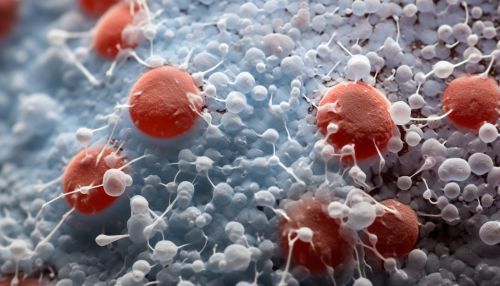Neutrophil granulocytes
Overview
Neutrophil granulocytes, often referred to simply as neutrophils, are the most abundant type of white blood cells in most mammals. They form an essential part of the innate immune system. Their functions vary from the destruction of bacteria and fungi to the regulation of inflammatory responses.


Structure
Neutrophils are a type of leukocyte, or white blood cell. They are characterized by the presence of granules in their cytoplasm. These granules are small vesicles filled with enzymes and other proteins that aid in the cell's immune response. Neutrophils are spherical in shape and have a diameter of about 12-15 micrometers. They possess a nucleus that is typically divided into two to five lobes, which is a characteristic feature of this cell type.
Function
Neutrophils play a vital role in the body's defense against infection. They are the first cells to arrive at the site of an infection, where they perform a variety of functions to combat invading pathogens.
Phagocytosis
One of the primary functions of neutrophils is phagocytosis, a process in which the cell engulfs and destroys foreign particles or microorganisms. Neutrophils are highly efficient phagocytes, capable of ingesting multiple bacteria or fungi.
Degranulation
Neutrophils also perform a function known as degranulation, in which they release the contents of their granules into the surrounding tissue. These granules contain a variety of antimicrobial substances, including enzymes and peptides, which can kill or inhibit the growth of bacteria and fungi.
Neutrophil Extracellular Traps (NETs)
In addition to phagocytosis and degranulation, neutrophils can also produce structures known as Neutrophil Extracellular Traps (NETs). These are networks of extracellular fibers, primarily composed of DNA from the neutrophil itself, that can trap and kill microbes.
Life Cycle
The life cycle of a neutrophil is relatively short, typically lasting only a few days. The cells are produced in the bone marrow from stem cells in a process known as hematopoiesis. Once mature, they are released into the bloodstream, where they circulate until they are recruited to a site of infection or inflammation.
Clinical Significance
Neutrophils are of significant clinical importance, as changes in their number or function can be indicative of various diseases.
Neutrophilia
An increase in the number of neutrophils, known as neutrophilia, can occur in response to a bacterial infection, inflammation, or certain types of cancer.
Neutropenia
Conversely, a decrease in the number of neutrophils, known as neutropenia, can leave the body more susceptible to infection. This condition can be caused by a variety of factors, including certain medications, radiation therapy, and some genetic disorders.
